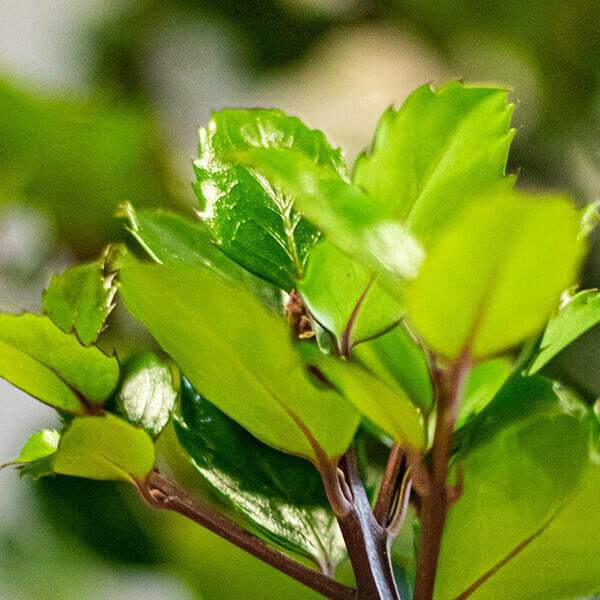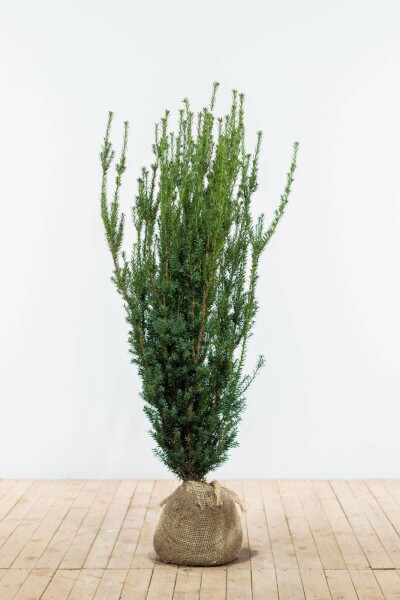Tall Hedging Plants For Maximum Privacy
Hedge Plants For Classic Borders
Boost your garden's attraction with lavish hedge ranges such as Yew (Taxus), Thuja, Laurel, Photinia, and Bamboo, commemorated for their structural integrity and environmental benefits.
Yew and Thuja provide evergreen protection and winter strength, while Laurel provides quick growth and broad, aromatic leaves.
Photinia includes seasonal beauty with its vibrant red foliage, and Bamboo provides a low-maintenance, serene ambiance.
These hedges improve air quality, decrease noise, and produce tranquil, personal spaces.
Appropriate planting, spacing, and upkeep ensure vigorous growth and eco-friendly consistency.
Explore how these lush ranges can raise your garden's beauty and well-being.
Key Takeaways
Change Your Garden With Lush Hedge Ranges
- Select Yew for its thick, evergreen growth and unparalleled longevity.
- Select Laurel for its quick development and broad leaves, ensuring quick personal privacy.
- Choose Photinia for its dynamic seasonal foliage, which turns a striking dark red.
- Use Bamboo for a low-maintenance, winter-hardy hedge with visual appeal.
- Area plants 2-3 per meter and prune frequently for optimum growth and health.
Popular Hedge Plants
When transforming a garden with lush hedge varieties, it's important to consider popular hedge plants such as Yew, Thuja, Laurel, and Photinia due to their distinct qualities and advantages.
Yew (Taxus) is extremely respected for its durability and thick, green development, making it a prime choice for withstanding landscapes.
Thuja is noted for its evergreen foliage and robust winter durability.
Photinia adds seasonal vibrancy with red leaves that darken in time, creating dynamic visual appeal.
Laurel uses rapid growth and aromatic, broad leaves, perfect for fast personal privacy.
Furthermore, Bamboo is an outstanding choice for ambiance, offering a low-maintenance, winter-hardy alternative that improves the garden's visual with its classy, swaying walking canes.
These choices cater to a variety of horticultural requirements and choices.
Benefits of Garden Hedges
Garden hedges offer a multitude of benefits, making them an important addition to any landscape. These natural barriers are economical to execute and provide substantial wind defense, improving air flow and contributing to sound decrease. The thick foliage of hedges like Thuja and Beech makes sure privacy by obstructing presence, producing a secluded and serene environment.
Hedges likewise play a vital function in microclimate regulation, supplying a stable environment that cultivates plant growth and minimizes temperature level fluctuations. Their detailed leaf structures filter contaminants, improving air quality and adding to a healthier garden community.
Additionally, hedges master sound reduction, taking in and deflecting sound waves to lower ambient noise levels. This double functionality of offering both acoustic and visual privacy improves the overall serenity and visual appeal of any garden.
Planting and Maintenance Tips
For a successful hedge, precise preparation of the planting location is crucial. Guarantee the soil has correct pH and drainage to support strong root development.
Area the plants properly for the chosen species. Water the hedge often throughout its preliminary development phase, changing as required with seasonal changes.
Execute a methodical pest control and disease avoidance strategy, using natural or chemical treatments when necessary. Routinely examine for aphids, termites, and fungal infections.
Apply mulch to retain moisture and suppress weeds. Seasonal pruning promotes dense growth and air flow, necessary for plant health.
Following these standards will help you cultivate a dynamic, properly maintained hedge that improves the beauty of your garden.
Spacing and Cutting Standards
Spacing and Cutting Standards
Correct spacing and trimming are crucial for cultivating healthy, visually appealing hedges. Sufficient spacing guarantees each plant receives sufficient nutrients, light, and airflow.
Follow these guidelines for optimal hedge upkeep:
- Spacing: Position hedge plants 2-3 plants per meter to encourage robust growth.
- Pruning Techniques: Regular pruning is necessary for keeping wanted hedge height and shape. Cut brand-new development in summertime and cut down older wood during winter.
- Seasonal Care: Adjust trimming methods and schedules according to seasonal requirements to ensure plant health.
- Hedge Height: Frequently display and cut to preserve the desired hedge height and achieve consistent visual appeals.
Complying with these steps will ensure your hedge flourishes, enhancing both the appeal and functionality of your garden.
Picking the Right Hedge
Selecting the Right Hedge
Selecting the appropriate hedge includes assessing aspects such as fully grown height, foliage density, and ecological durability. Effective hedge plant choice requires comprehending each species' development attributes and site-specific adaptability.
For instance, Yew (Taxus) provides excellent longevity and thick growth, while Thuja is significant for its winter strength. Furthermore, thinking about upkeep requirements is crucial; fast-growing types like Laurel or Privet demand regular trimming, whereas low-maintenance choices like Bamboo or Ivy may be more suitable for those seeking minimal maintenance.
Environmental aspects such as soil type, light availability, and wetness conditions need to also assist the choice process. This mindful approach guarantees the picked hedges will flourish, supplying both aesthetic and functional benefits to the garden landscape.
Delivery and Planting Guidance
To guarantee your hedge plants thrive, they must be provided by specialized couriers and planted quickly upon arrival.
Follow these necessary actions for effective planting:
- Soil Preparation: Enhance the soil with organic matter to enhance drain and nutrient material.
- Planting Depth: Create a trench twice the width and equivalent to the depth of the root ball.
- Watering Strategies: Water completely after planting, keeping the soil consistently wet but not filled.
- Mulching: Apply a layer of mulch to retain moisture and reduce weeds.
Consumer Assistance and Service
Offered the crucial role of timely support in horticultural pursuits, our customer support team is offered 6 days a week through telephone, e-mail, and social networks to use skilled advice and swiftly address any concerns. Their devotion to fast action times makes sure consumer satisfaction by resolving queries related to plant health, optimal planting methods, and maintenance schedules.

Schedule
Within 24 hours
This detailed support group, enhanced by a stellar 9.3/ 10 client score, highlights our dedication to boosting the gardening experience for every single customer.
Regularly Asked Concerns
The Length Of Time Does It Consider Hedge Plants to Establish?
Hedge plants normally need one to 3 years to end up being completely established, with the precise duration varying by species and growing conditions.
Effective care throughout this critical period is vital for robust growth. Consistent watering, vigilant weed control, and appropriate fertilizer application are pivotal in promoting strong root advancement.
For example, fast-growing species like Laurel may establish faster, while slower-growing ranges such as Yew may take longer. Persistent maintenance accelerates the facility process, resulting in dense and healthy hedges.
What Are the Best Hedge Plants for Privacy?
The concern of the very best hedge plants for privacy involves examining evergreen and deciduous options.
Evergreen hedges like Thuja, Laurel, and Cypress provide year-round protection, making sure continuous privacy.
On the other hand, deciduous hedges such as Beech provide seasonal privacy, shedding leaves in colder months.
Secret maintenance pointers for privacy hedges consist of regular cutting, fertilizing in spring, and appropriate spacing-- typically 2 to 3 plants per meter.
In addition, consistent watering and thorough weed removal are crucial for promoting healthy, thick growth.
Can Hedge Plants Attract Wildlife to My Garden?
Yes, hedge plants can bring in wildlife to your garden by offering essential advantages like shelter, food, and nesting sites, consequently enhancing regional biodiversity. Yew, holly, and laurel are excellent for drawing in birds, while ivy supports a variety of bugs.
However, it is necessary to note that there are some disadvantages, such as increased upkeep to manage insects and regular upkeep. Thoroughly selecting and preserving hedge ranges can help stabilize these downsides and benefits, ultimately cultivating a lively and sustainable environment in your garden.
Are There Any Flowering Hedge Plants Available?
Yes, there are flowering hedge plants offered that can boost the beauty of your garden.
For example, Elaeagnus, likewise called Olive Willow, produces aromatic white flowers in the fall, adding a touch of elegance.
Photinia, another popular choice, showcases dynamic red leaves that grow into a rich green, creating a vibrant visual effect throughout the seasons.
To guarantee these plants prosper, it's important to practice proper pruning methods and seasonal maintenance, such as cutting brand-new development in the summer season and cutting back in the winter season.
These measures will help preserve the health and visual appeal of your blooming hedges.
How Do I Avoid Insects in My Hedge Plants?
To prevent bugs in hedge plants, use natural pest control methods and maintain proper hedge care. Present useful pests like ladybugs, which victimize damaging bugs, to develop a balanced ecosystem.
Regularly inspect your hedges for signs of problem and promptly eliminate any affected parts to prevent the spread. Ensure the health of your hedges by applying balanced fertilizers and offering adequate water.
Utilize mulching to retain soil wetness and appropriate spacing to lower plant tension and promote robust development. These practices jointly help in reducing pest concerns and keeping a healthy hedge.
Conclusion
In essence, selecting the best hedge varieties such as Yew, Thuja, and Laurel can transform any garden into a tranquil sanctuary. These plants offer Additional resources year-round plant, improve visual appeal, and deal practical benefits like sound reduction and wind protection.
Appropriate planting techniques, precise spacing, consistent watering, and seasonal trimming are essential for ideal development.
Trustworthy shipment services and expert consumer support make sure a seamless experience from purchase to planting, making it easier than ever to elevate your outside space.
Garden hedges offer a wide variety of benefits, making them an important addition to any landscape. These natural barriers are economical to implement and offer significant wind security, enhancing air blood circulation and contributing to noise decrease. The thick foliage of hedges like Thuja and Beech guarantees personal privacy by obstructing presence, creating a secluded and tranquil environment.

Pruning Methods: Regular pruning is essential for keeping preferred hedge height and shape. Trim brand-new development in summer and cut back older wood throughout winter.